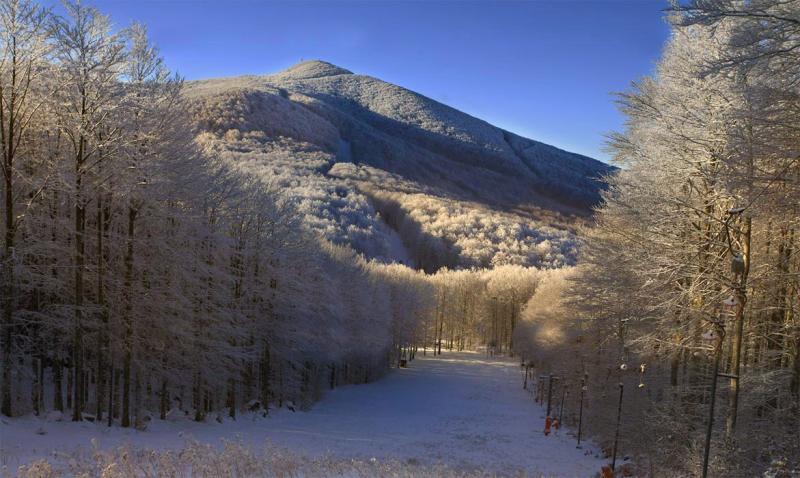December marks the start of the short ski season on Mt Amiata Italy’s highest extinct volcano. This distinctive small resort is 500 kilometres south of the mighty skiing mecca of the Dolomites in a part of southern Tuscany synonymous with baking summers, rolling hills, olive groves and quaint hilltop towns. Its close proximity to the cultural giants of Siena and Florence and the 15km of ski runs that snake through the beauty of Europe’s largest beech forest make it a perfect place to combine a leisure and sightseeing holiday.
Immersed in history
This sacred mountain of the ancient Etruscans divides the Val D’Orcia from the flat fertile plains of the unspoilt Tuscan Maremma. From the monumental iron cross on its summit views stretch as far as Lake Trasimeno in Umbria where Hannibal achieved his greatest triumph over the Romans, the Chianti Hills, the wild Parco Regionale della Maremma beyond which is the secretive island of Montecristo and Elba where Napoleon stayed whilst in exile. Amiata’s strength is its peacefulness and simplicity. Huddled around the small meadow at the resort’s main hub of Prato delle Macinaie are a trio of cosy bars serving skiers the excellent local red wine Montecucco as well as the friendly and award winning hotel Le Macinaie and restaurant which is only twenty paces from the ticket office and main chairlift.

The surrounding area
For culture you don’t even need to venture as far as Siena or Florence. For renaissance architecture and the world’s finest red wine take a short drive north of Amiata to the picture perfect medieval hilltop towns of Pienza, Montepulciano and Montalcino making time to visit the idyllic isolated Benedictine Abbey of Sant’ Antimo. Just 45 minutes south of the mountain discover the stunning tufa towns of Sovano and Sorano and most especially Pitigliano, unquestionably the most visually dramatic town in the whole of southern Tuscany. Take the opportunity to visit one of the dozens of Etruscan burial sites all over this area.
The immediate surroundings of Amiata are no less appealing. Follow any of the crippling steep roads down from Prato Macinaie to visit the cluster of beautiful medieval towns that circle the lower slopes and it is easy to understand why the great Italian cyclist Marco Pantani chose Amiata as one of his training bases. At the regions principle town of Abbadia San Salvatore visit the oldest monastery in Tuscany with its wonderful 8th century columned crypt. This important institution on the ancient Via Francigena, the pilgrim route from northern Europe to Rome, brought the region significant power, wealth and influence in the middle ages. The town is also home to the Parco Museo Minerario, a museum showcasing the time Amiata controlled the world’s most important mercury mines.

Montalcino, Siena - Abbazia di Sant'Antimo
To learn about Amiata’s most famous person head to Arcidosso. The David Lazzaretti museum explains the extraordinary life of the charismatic prophet of Amiata who was shot for his beliefs by the Carabinieri in 1878. The large town is worth a visit alone for its Aldobrandeschi castle and faded pastel coloured houses. The region’s smaller settlements of Castel Del Piano, Castel’Azzara, Vivo d’Orcia, Piancastagnaio and Castiglione d’Orcia offer visitors a mix of wonderful views, pretty streets and fine churches and do not miss a stop in Santa Fiore, a place noted by Dante for its craggy impenetrable position to visit the churches of Santa Fiora e Lucilla and Sant’ Agostino.
Reaching the coast and Tuscany’s major cities
The mount Amiata resort is within two hours of both Siena and Florence making it possible one day to be slaloming Amiata’s quiet slopes and riding the chairlifts high above the canopy of enormous beech trees and the next be dining on the sloping Piazza del Campo, home of the Palio horse race in Siena, or studying a Botticelli at the 
Siena - Piazza Del Campo
Food, wine and olive oil
On top of all this Amiata maintains Tuscany’s tradition of producing top quality ingredients. Restaurants maximise use of local pecorino cheese, honey and breads and the regions celebrated porcini mushrooms and chestnuts, including the eccentrically named ‘bastarda rossa’ variety. At the village of Seggiano, take a tour of a traditional oil mill and visit an enoteca to dip some bruschetta into its world famous olive oil before visiting the 16th century renaissance Church of Madonna della Carità and the works of the eclectic contemporary artist Daniel Spoerri at the gardens named after him. The skiing on Mount Amiata and its proximity to some of the best and often little explored parts that Tuscany has to offer make it a wonderful winter holiday destination. To end a trip in style head to one of the natural thermal springs which derive their heat from the volcanic roots of the mountain. There are excellent bathing centres at Bagni Vignoni, San Casciano dei Bagni and Bagni S.Filippo.
The official Mt Amiata ski website www.amiataneve.it
More news about Tuscany
Map of Tuscany.
Accommodation in Tuscany.
Properties for Sale in Tuscany.










